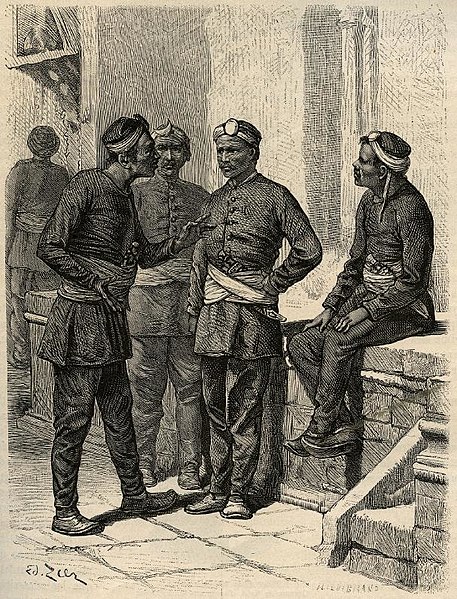The Anglo-Nepalese War, also known as the Gorkha War, was fought between the Gorkhali army of the Kingdom of Nepal and the British forces of the East India Company. Both sides had ambitious expansion plans for the mountainous north of the Indian Subcontinent. The war ended with the signing of the Sugauli Treaty in 1816, which ceded some of the Nepalese-controlled territory to the EIC.
Bhakti Thapa (yellow) leading Nepalese Gurkhali Army against British forces
Bhimsen Thapa, prime minister of Nepal from 1806 to 1837.
Francis Edward Rawdon, Marquess of Hastings, Governor-General of India from 1813 to 1823.
Officer and Private, 40th Regiment of Foot, 1815
The Nepali Army, also referred as the Gorkhali Army, is the land service branch of the Nepali Armed Forces. After the Gorkha Kingdom was founded in 1559, its army was established in 1560, and was accordingly known as the Gorkhali Army. The army later became known as the Royal Nepali Army (RNA) following the Unification of Nepal, when the Gorkha Kingdom expanded its territory to include the whole country, by conquering and annexing the other states in the region, resulting in the establishment of a single united Hindu monarchy over all of Nepal. It was officially renamed simply to the Nepali Army on 28 May 2008, upon the abolition of the 240-year-old Nepalese monarchy, and of the 449-year-old rule of the Shah dynasty, shortly after the Nepalese Civil War.
Nepal Army's Guruju Paltan (a ceremonial infantry company) in traditional uniform
Khukuri, Karda and Chakmak. Khukuri is the symbolic weapon of the Nepali Army
Nepali national soldiers by Gustave Le Bon, 1885
Nepal Army soldiers on Army Day








